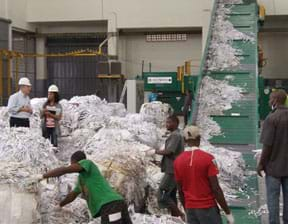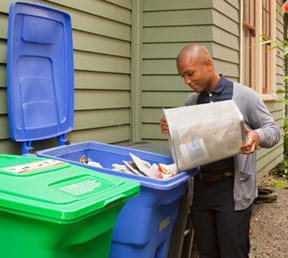Quick Look
Grade Level: 1 (K-2)
Time Required: 45 minutes
(plus drying time)
Expendable Cost/Group: US $1.00
Group Size: 3
Activity Dependency: None
Subject Areas: Physical Science, Science and Technology
NGSS Performance Expectations:

| K-ESS3-3 |
Summary
Students learn how paper is made. Working together, student teams make their own paper. This activity introduces students to recycling; what it is, its value and benefits, and how it affects their lives.
Engineering Connection
As landfills are filling up and raw resources are depleting, recycling is becoming more necessary and cost effective. Engineers develop technologies to improve the efficiency of recycling human-made materials. Recycled paper is becoming increasingly common as more people recognize the value of discarded materials for new use, are recycling unwanted materials, and are evolving new methods to make the process more efficient.
Learning Objectives
After this activity, students should be able to:
- Understand how paper is made.
- Learn how new paper can be made from old, used paper.
- Know the value of recycling.
Educational Standards
Each TeachEngineering lesson or activity is correlated to one or more K-12 science,
technology, engineering or math (STEM) educational standards.
All 100,000+ K-12 STEM standards covered in TeachEngineering are collected, maintained and packaged by the Achievement Standards Network (ASN),
a project of D2L (www.achievementstandards.org).
In the ASN, standards are hierarchically structured: first by source; e.g., by state; within source by type; e.g., science or mathematics;
within type by subtype, then by grade, etc.
Each TeachEngineering lesson or activity is correlated to one or more K-12 science, technology, engineering or math (STEM) educational standards.
All 100,000+ K-12 STEM standards covered in TeachEngineering are collected, maintained and packaged by the Achievement Standards Network (ASN), a project of D2L (www.achievementstandards.org).
In the ASN, standards are hierarchically structured: first by source; e.g., by state; within source by type; e.g., science or mathematics; within type by subtype, then by grade, etc.
NGSS: Next Generation Science Standards - Science
| NGSS Performance Expectation | ||
|---|---|---|
|
K-ESS3-3. Communicate solutions that will reduce the impact of humans on the land, water, air, and/or other living things in the local environment. (Grade K) Do you agree with this alignment? |
||
| Click to view other curriculum aligned to this Performance Expectation | ||
| This activity focuses on the following Three Dimensional Learning aspects of NGSS: | ||
| Science & Engineering Practices | Disciplinary Core Ideas | Crosscutting Concepts |
| Communicate solutions with others in oral and/or written forms using models and/or drawings that provide detail about scientific ideas. Alignment agreement: | Things that people do to live comfortably can affect the world around them. But they can make choices that reduce their impacts on the land, water, air, and other living things. Alignment agreement: Designs can be conveyed through sketches, drawings, or physical models. These representations are useful in communicating ideas for a problem's solutions to other people.Alignment agreement: | Events have causes that generate observable patterns. Alignment agreement: |
International Technology and Engineering Educators Association - Technology
-
Compare the natural world and human-made world.
(Grades
Pre-K -
2)
More Details
Do you agree with this alignment?
-
Select ways to reduce, reuse, and recycle resources in daily life.
(Grades
Pre-K -
2)
More Details
Do you agree with this alignment?
-
Explain that materials are selected for use because they possess desirable properties and characteristics.
(Grades
Pre-K -
2)
More Details
Do you agree with this alignment?
-
Collaborate effectively as a member of a team.
(Grades
Pre-K -
2)
More Details
Do you agree with this alignment?
-
Describe qualities of everyday products.
(Grades
Pre-K -
2)
More Details
Do you agree with this alignment?
State Standards
Massachusetts - Science
-
Identify and explain some possible uses for natural materials (e.g., wood, cotton, fur, wool) and human-made materials (e.g., plastic, Styrofoam).
(Grades
Pre-K -
2)
More Details
Do you agree with this alignment?
Materials List
For each group:
- rectangular cake pan
- wire mesh screen (cut to be smaller than the cake pan)
- toilet paper (single ply breaks down faster)
- mixing bowl
- metal fork (or blender)
- rolling pin
- water
- paper towels or newspapers
Worksheets and Attachments
Visit [www.teachengineering.org/activities/view/make_recycled_paper] to print or download.Introduction/Motivation

Almost half of all the trash produced by humans is paper. Recycling paper has many benefits, such as reducing human impact on the environment by using fewer trees and reducing the amount of trash dumped in landfills. Environmental engineers continually think of new ways to protect the Earth and the environment. Their jobs include recycling as well as cleaning up water and air pollution, trash disposal, and making sure people and animals stay healthy living in their environments. By recycling, you are learning how to protect the environment for your lifetimes as well as future generations.
Procedure
Background
Paper is made mostly from wood. Several chemicals are also added to make it more durable. In addition to saving trees, recycling used paper, including newspaper and boxes, also helps to reduce the amount of trash that ends up in landfills.
New paper is made by removing the bark from timber and cutting the wood into small chips. The small fragments are pressure cooked while chemicals are added. The paper goes through the processes of cleaning, refining and bleaching, turning the wood pulp into a fine slush. The slush is pumped onto a wire screen where it dries and becomes a continuous sheet of paper on a roll.

In a big recycling factory, mostly newspaper and cardboard boxes are recycled. The used paper is put through the chemical process of de-inking, then placed into a huge blender with water and beaten until the paper is broken down into small fibers. The fibers are pressed in screens to remove the water, flattened and dried to result in paper.
Before the Activity
- Gather materials.
- Cover the work table with paper towels or newspapers.
With the Students
Talk with students about recycling and discuss why recycling is important. Arrange the students into groups. Have groups collect the materials and set up their workstations.
- Fill a bowl 3/4 full with warm water. Tear the toilet paper into small pieces and place them into the water. Beat the mixture with a fork or a blender until the paper is broken down into fibers. Pour the mixture into the cake pan.
- Make a frame from the screen by folding the edges over. Slide the frame into the pan from the side so it is under the fibers. Lift the screen straight up through the water so it is covered in fibers as the water drains away.
- After the water has stopped dripping, place the screen on some paper towels or newspapers. Fold the paper towels over the screen so that the fibers are covered. Press with a rolling pin to absorb any excess water.
- Remove the paper towels and let the paper dry.
- Once the paper is completely dry, remove it from the screen and re-use the screen to make new sheets of paper.
Vocabulary/Definitions
recycling: The act of processing used or abandoned materials for use in creating new products.
Assessment
Discussion: After the activity, lead a class discussion, asking students the Investigating Questions. Their answers reveal their comprehension of the activity content.
Rubric: Use the Rubric for Performance Assessment to evaluate groups' success in making their own recycled paper by evaluating their depth of understanding of the concepts and teamwork during the activity.
Making Sense: Have students reflect about the science phenomena they explored and/or the science and engineering skills they used by completing the Making Sense Assessment.
Investigating Questions
- How is paper made?
- From what is paper made?
- What are benefits of recycling paper?
- What happens to the pieces of tissue when you add water? When you mix it?
- What does the paper look like when it begins to dry?
- What other materials could be used to make paper?
- How would you make colored paper?
- What would you do differently to make your paper better?
- How would you use the paper that was made?
- Why would you want to make new paper from used paper?
Subscribe
Get the inside scoop on all things TeachEngineering such as new site features, curriculum updates, video releases, and more by signing up for our newsletter!More Curriculum Like This

Students expand their understanding of solid waste management to include the idea of 3RC: reduce, reuse, recycle and compost. They look at the effects of packaging decisions (reducing) and learn about engineering advancements in packaging materials and solid waste management.
Copyright
© 2013 by Regents of the University of Colorado; original © 2004 Worcester Polytechnic InstituteSupporting Program
Center for Engineering Educational Outreach, Tufts UniversityLast modified: April 13, 2022






User Comments & Tips